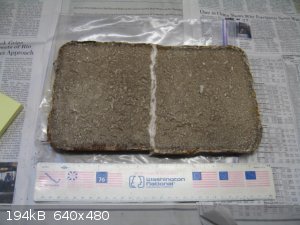| Pages:
1
2 |
blogfast25
International Hazard
    
Posts: 10562
Registered: 3-2-2008
Location: Neverland
Member Is Offline
Mood: No Mood
|
|
If there really is chromium in there it's probably deliberate, as it increases corrosion resistance of steel a lot: see stainless steel. Good work.
Personally, I would repeat the test for lead chromate by carefully filtering the supernatant solution of that tube on the right. Check its colour.
Then add quite a bit of lead nitrate solution. Right now your result isn't 100 % conclusive. Fe(OH)3 has a tendency to peptise.
[Edited on 17-10-2013 by blogfast25]
|
|
|
Gometal
Harmless

Posts: 1
Registered: 4-12-2013
Member Is Offline
Mood: No Mood
|
|
The catalytic converter you are trying to refine is called a stainless. The material in side of the converter is called a stainless wrap. Not very
common converter or material used in converters. The best way to extract the material is to pick a part the stainless and seperate the powder from
the stainless. We yielded 24.6 grams of palladium at a 98% purity on a converter called the Torpedo with a street value of $180.00 give or take
depending on who you sell to. There are many converters that yield 100% profits margins the hard part is finding them. We used the same process
Fleaker has described previously. You will lose on overall yield but Make up the difference in a higher % of spot market price.
|
|
|
Magpie
lab constructor
    
Posts: 5939
Registered: 1-11-2003
Location: USA
Member Is Offline
Mood: Chemistry: the subtle science.
|
|
I bought a used propane catalytic heater at a garage sale a few years ago with the idea that I could recover the PGM from it. A picture of the
catalyst is shown below. It is ~0.56 ft2 x 1/2" thick.
Does anybody have any idea what PGM it contains and what amount in grams it is likely to contain?

The single most important condition for a successful synthesis is good mixing - Nicodem
|
|
|
Jimmymajesty
Hazard to Others
  
Posts: 153
Registered: 9-7-2009
Member Is Offline
Mood: No Mood
|
|
I have <0.3wt% H2PdCl6 in AlCl3/Hcl pH~0.1 solution. I wanted to recover the Pd from a catalytic converter.
This can not be filtered as it is a crystalline mass at room temp, when hot the colloid SiO2 particles clog the filter in no time or it may be too
thick even then I am not sure.
I tried to cement out the Pd with Al rods by heating it up till all the AlCl3 went into solution => a black colloidal Pd was obtained that does not
settle, goes trough filter paper as well.
Redissolved the solution with Cl2 gas then tried to cement out with copper, I got the same colloid.
Now... what the hell? Is this supposed to be this difficult? This PGM recovery career of mine together with this solution will end up in the sink at
this rate pretty soon.
BTW Magpie have you got the answer to you question?
|
|
|
| Pages:
1
2 |